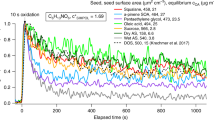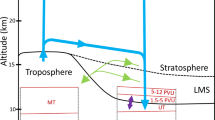Abstract
Atmospheric acetone serves as a precursor of PAN (peroxyacetyl nitrate) which represents a temporary reservoir for reactive nitrogen and has a potential to form aerosols. Acetone has recently been detected in the atmosphere by Penkett2, using ground-level flask sampling and gas chromatography/mass spectrometry (GC/MS) analysis in the laboratory finding an average volume mixing ratio of 470 p.p.t.v. (parts per 1012 by volume) in Atlantic air. Very recently, acetone was for the first time detected in the free atmosphere, at heights around the tropopause, by Arnold and his colleagues3,4 using aircraft-borne chemical ionization mass spectrometry (CIMS). We report here on the first measurements of atmospheric acetone abundances over an extended altitude range (5,900–11,300 m) covering the lowermost part of the stratosphere and the upper troposphere. The measured upper tropospheric abundances (average 120 p.p.t.v.) are substantially lower than the average values (470 p.p.t.v.) measured at ground level. Above the tropopause, a marked decrease of the acetone mixing ratio was observed. Our present data have interesting implications for the chemistry of non-methane hydrocarbons and possibly also hydroxyl radical abundances.
This is a preview of subscription content, access via your institution
Access options
Subscribe to this journal
Receive 51 print issues and online access
$199.00 per year
only $3.90 per issue
Buy this article
- Purchase on Springer Link
- Instant access to full article PDF
Prices may be subject to local taxes which are calculated during checkout
Similar content being viewed by others
References
Singh, H. B. & Hanst, P. L. Geophys. Res. Lett. 8, 941–944 (1981)
Penkett, S. A. in Atmospheric Chemistry (ed. Goldberg, E. D.) (Springer, Berlin, 1982).
Hauck, G. & Arnold, F. Nature 311, 547–550 (1984).
Arnold, F. & Hauck, G. Nature 315, 307–309 (1985).
Heitmann, H. & Arnold, F. Nature 306, 747–751 (1983).
Arnold, F., Heitmann, H. & Oberfrank, K. Planet. Space Sci. 32, 1567–1576 (1984).
Knop, G. & Arnold, F. Planet Space Sci. 33, 983–986 (1985).
Gardner, E. P., Ranmali, D., Wijayaratne, R. D. & Calveri, J. G. J. phys. Chem. 88, 5069 (1984).
Crutzen, P. in Atmospheric Chemistry (ed. Goldberg, E. D.) 313–328 (Springer, Berlin 1982).
Liu, S. C., McAfee, J. R. & Cicerone, R. C. J. geophys. Res. 89, 7291– (1984).
Chatfield, R. B. & Crutzen, P. J. Geophys. Res. 89, 7111 (1984).
Ehhalt, D. H. & Rudolph, J. KFA Rep. ISSN 0366-0885 (July 1984).
Rudolph, J. & Ehhalt, D. H. J. geophys. Res. 86, 11959 (1981).
Darnall, K. R., Atkinson, R. & Pitts, J. N. Jr J. Phys. 82, 1581 (1978).
Wang, C. C., Davis, L. I. Jr & Selzer, P. M. J. geophys. Res. 86, 1181–1186 (1981).
Watanabe, T. et al. Analyt. Chem. 54, 2470–2474 (1982).
Author information
Authors and Affiliations
Rights and permissions
About this article
Cite this article
Arnold, F., Knop, G. & Ziereis, H. Acetone measurements in the upper troposphere and lower stratosphere—implications for hydroxyl radical abundances. Nature 321, 505–507 (1986). https://doi.org/10.1038/321505a0
Received:
Accepted:
Issue Date:
DOI: https://doi.org/10.1038/321505a0
This article is cited by
-
Theoretical studies and rate constants calculation for the reactions of acetone with fluorine and bromine atoms
Theoretical Chemistry Accounts (2011)
-
Theoretical studies on the reactions OH + CH3COCCl2 X (X = F, Cl, Br)
Theoretical Chemistry Accounts (2009)
-
Characteristics of carbonyl compounds in ambient air of Shanghai, China
Journal of Atmospheric Chemistry (2008)
-
Theoretical studies on the reactions of acetone with chlorine atom and methyl radical
Theoretical Chemistry Accounts (2008)
-
High concentrations and photochemical fate of oxygenated hydrocarbons in the global troposphere
Nature (1995)
Comments
By submitting a comment you agree to abide by our Terms and Community Guidelines. If you find something abusive or that does not comply with our terms or guidelines please flag it as inappropriate.



